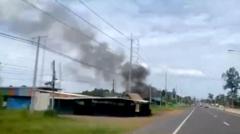In July, a sudden flare of violence erupted on the border between Thailand and Cambodia, marking a severe deterioration in relations, with reports confirming at least 12 deaths among Thai nationals, primarily civilians. Conflict has resurfaced over historical land disputes dating back more than a century, exacerbated in 2008 after Cambodia’s moves to declare an 11th-century temple, located on the contested border, a UNESCO World Heritage site. Clashes have been intermittent, intensifying significantly following the killing of a Cambodian soldier earlier this year, plunging bilateral relations to a low not seen in over a decade.
Accusations from both nations have fueled this conflict. The Thai National Security Council claims that Cambodian forces initiated hostilities by deploying drones and engaging in a rocket assault. In contrast, Cambodian officials assert that Thailand provoked the confrontation by moving troops towards a sacred temple and subsequently firing into the air. This cycle of blame reflects underlying tensions and mutual distrust that have long characterized relations between the two countries.
As military presence increases on both sides, and with recent border restrictions such as Cambodia’s prohibition of Thai imports, fears of an all-out war loom. Nonetheless, both Prime Ministers have indicated a desire for a peaceful resolution, yet concerns over the evident lack of strong leadership capable of de-escalating the confrontation persist.
Travel advisories remain cautious but have not led to heightened alerts for travelers, though the British Foreign Office has recommended exercising care in the area. Given the localized nature of the violence, the situation is still deemed manageable, unless further escalations occur.
With historical tensions at the forefront, the hope remains that diplomatic efforts can reclaim ground lost to conflict, though the path forward remains uncertain amid rising militaristic postures from both Thailand and Cambodia.
Accusations from both nations have fueled this conflict. The Thai National Security Council claims that Cambodian forces initiated hostilities by deploying drones and engaging in a rocket assault. In contrast, Cambodian officials assert that Thailand provoked the confrontation by moving troops towards a sacred temple and subsequently firing into the air. This cycle of blame reflects underlying tensions and mutual distrust that have long characterized relations between the two countries.
As military presence increases on both sides, and with recent border restrictions such as Cambodia’s prohibition of Thai imports, fears of an all-out war loom. Nonetheless, both Prime Ministers have indicated a desire for a peaceful resolution, yet concerns over the evident lack of strong leadership capable of de-escalating the confrontation persist.
Travel advisories remain cautious but have not led to heightened alerts for travelers, though the British Foreign Office has recommended exercising care in the area. Given the localized nature of the violence, the situation is still deemed manageable, unless further escalations occur.
With historical tensions at the forefront, the hope remains that diplomatic efforts can reclaim ground lost to conflict, though the path forward remains uncertain amid rising militaristic postures from both Thailand and Cambodia.





















